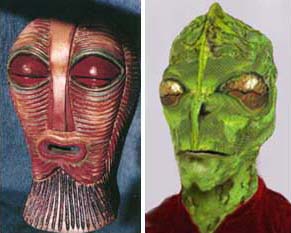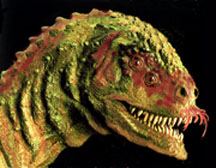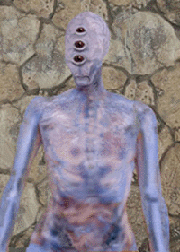Home
My Work
New Works
Artwork
Games
Writing
Print Books
Short Stories
Non-Fiction
Novels
Audio Books
E-Books
Full Bibliography
Awards
About Me
Biography
Pseudonyms
Cons & Events
Links
Site Map
|
Some Alien Friends of Mine
I love creating aliens; especially non-humanoid,
truly alien aliens. This page has pictures
of the various aliens in my books, together with brief descriptions and
speculative ramblings about them.

An
This alien critter was introduced in the
Galactic
Marines saga from
Avon Eos. We get only an uninformative glimpse of this fellow in the second book
of the Heritage trilogy,
Luna Marine, where he is described as "Species 84,"
a representative of one of many alien civilizations recorded in a visual
library or communications facility built by advanced alien colonizers beneath
the Martian surface half a million years ago.
Though we don't see much of him directly, we do learn that his
species, the An, were spacefarers several thousand years ago, that they
left wreckage and ruins on our Moon, and that they colonized parts of our
Earth between six and twelve thousand years ago, building numerous cities
and enslaving -- and civilizing -- the local human populations. Eventually,
they were all but exterminated by another culture known only as "the Hunters
of the Dawn." The struggle destroyed the An's colony centers on Earth and
on the Moon, flooded vast stretches of Mesopotamia and the Nile Delta,
and left scattered bands of former slaves to begin the laborious process
of building a new civilization on their own.
In creating the An, I borrowed heavily from Sumerian myth, and from
the fact that both the Sumerian and Egyptian cultures appeared relatively
suddenly, with a degree of sophistication, from obscure backgrounds: both
credited civilization to the gods who formerly walked among humans as their
creators and masters; and both have mythologies that read more like science
fiction than religion.
In Luna Marine, I did considerable research into
both Sumerian myth and language, using, wherever possible, actual Sumerian
words and phrases. In the Sumerian mythos, both heaven and the supreme
creator-deity were called "An" or, in later versions, "Anu." Their name
for Earth was Ki, a word that made its way to Greece as "gi" or
"geos" and on to modern English through such words as "geometry" and "geology."
The Moon was called Kingu, which means something like "Defender
of the Earth."
A number of gods who came to Earth from An were known as the "Annunaki,"
roughly translated as "Those of Heaven Who Came to Earth." The Annunaki
were credited with everything from the creation of Man to the invention
of agriculture, domesticated animals, religion, money, language, and writing.
In the Heritage trilogy, the An are described as pseudoreptilian, homeothermic,
and vivaparous. Despite the fact that I dislike having to rely on humanoid
aliens, the An are indeed humanoid ... mostly because the representations
of the Annunaki in Sumerian art, of Oannes in the remarkable Sumerian story
of an amphibious civilizer from Sirius related by Berossus, and of the
"Neteru" or "Watchers" in Egyptian mythology, are all of human or human-like
figures. The An have six digits on each hand, which is why we, today, still
have base twelve and base sixty numerical systems in our time keeping,
calendars, and zodiac -- all passed down to us from the Sumerians by way
of ancient Babylon. They have an architectural predilection for flat-topped
pyramids, which explains the interest in those structures both in Egypt
(I've assumed that the tops of the Great Pyramids were added on later,
in Pharaonic times) and in the ziggurats of Sumeria, as well as, possibly,
the pyramids in Mesoamerica.
Their ancient starfaring culture was completely destroyed by the Hunters
of the Dawn, but isolated colonies did survive, albeit as stone-age primitives.
The nearest we know of so far is on the Earthlike satellite of a gas giant
in the Lalande 21185 star system, only nine light years from Earth. If
all goes as planned, the first book of the second Heritage trilogy
will at least partly follow Earth's first expedition to that system, complete
with a complement of U.S. Marines embarked on board the starship.
|

Twins separated at birth?
On the left, a photo of a mask of unknown origin, downloaded off the Internet.
On the right, an illo of an An, created before I saw the mask photo.
The guy who posted the photo thought it reminded him of an ancient Sumerian
fish-god. Shades of the amphibious Oannes (An-ess?) of Berossus!
|

Malach
This charming individual is Deathgiver Aghrracht the Swift-Slayer, one
of the unpleasant, militant-Darwinian aliens called Malach in the novel
Bolo Brigade. The Malach -- give that "ch"
sound a harsh German "ch", as in "Bach" -- are a race of intelligent carnivores
from a world called Zhanaach somewhere in the star-thin reaches beyond
the rim of our galaxy. The stars out there tend to be old and poor in the
heavier elements; consequently, their worlds are metal-poor, and any intelligent civilizations
arising there have to be extremely competitive and aggressive simply to
survive.
It's a damned tough universe, out there....
The Malach have overcome their ancestral limitations through a philosophy
that might best be described as "militant Darwinism." They've taken the
idea of survival of the fittest and boosted it to the level of a racial
religion. The Malach name for themselves is Ma'ala'acht, which translates
roughly as the Race of We Who Survived.

Outwardly, the Malach somewhat resemble certain carnivorous dinosaurs
from Earth's prehistory, swift, savage, bipedal predators such as Deinonychus
and Velociraptor. Zhanaachan evolution has derived from six-limbed vertebrates;
Malach possess two powerful walking legs equipped with large, slasher claws,
and four smaller, manipulatory arms with sharp-clawed, grasping hands.
They have four eyes, and their sharp-fanged mouths are rimmed by pink feeding
tendrils. Their bodies are covered by tough scales, brightly colored in
emerald green and scarlet. The colorful, striped pattern probably blends
in well with the background flora native to Zhanaach.
Malach are pack hunters and tend to feel uncomfortable in enclosed
spaces or when alone. Despite this, their military technology has developed
powerful walking/flying devices called Hunters, piloted by individual Malach
warriors riding inside. Malach tactics involve the deployments of large
numbers of Hunters, hordes that overwhelm an opponent in the wild, sharp
thrill of UrrghChaak, the Blood Chase.
The Malach are a matriarchal society. The females are quite intelligent;
males are considerably smaller and relatively unintelligent, contributing
nothing to Malach society except their reproductive functions. At times,
sex becomes a public ceremony of union and duty in Malach culture; several
males fight one another to the death, with the survivor publicly mating
with a female. The female, aroused by the smell of blood, decapitates the
male during the proceedings, which enables him to complete the sexual act.
Later, the embryos are transferred to a brooder, an unintelligent creature
closely related to the Malach. The young eventually eat their way out of
the brooder; the females are welcomed into Malach society in a blood ceremony,
while the males are kept segregated in a special care facility until they
are old enough to breed.
Interestingly, all of the features of Malach reproduction have counterparts
in various organisms found elsewhere throughout the Galaxy, including Earth.
The female praying mantis bites off the male's head during copulation,
which seems to eliminate any inhibitions the male was experiencing. The
use of other species as living incubators is common in a number of parasitic
species, notably in certain species of wasp. |

Kluj
For those of you who missed his presentation under "Alien of the Month"
(which was, admittedly, a long time ago),
here is Dahnak, a Kluj from the world of Klushtha and one of the Watchers
who've been studying humans from a base hidden on Earth's moon. He has
translucent, bluish skin, two hearts, and a hemoglobin-analog based on
cupric sulfate. While he can manage well enough in Earth's atmosphere --
with some technological assistance -- certain alkaloid compounds, including
caffeine and chocolate, are poisonous to him.
As those of you who've discussed the matter with me can attest, I have
a thing about humanoid aliens. When we encounter ETI, I strongly suspect
that they will not be "just like us," with only minor variation
in skin color or shape of ears. In Diplomatic Act, it turns out
that the Kluj are among the most humanlike in body shape and articulation
of all of the myriad species of the Galactic Unity ... a fact that allows Dahnak to disguise himself as a human. Yes, he's able to pull it off. Let's
just say that nanotechnology is involved.... |
All text and artwork copyright (c) William H. Keith
This page was last updated on
05/28/2011
|




